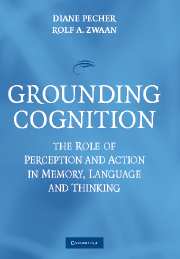Book contents
- Frontmatter
- Contents
- List of Contributors
- 1 Introduction to Grounding Cognition: The Role of Perception and Action in Memory, Language, and Thinking
- 2 Object Concepts and Action
- 3 Constraints on Spatial Language Comprehension: Function and Geometry
- 4 Embodiment in Metaphorical Imagination
- 5 Passionate Thoughts: The Emotional Embodiment of Moral Concepts
- 6 Grounding Language in Bodily States: The Case for Emotion
- 7 Situating Abstract Concepts
- 8 Dynamicity, Fictivity, and Scanning: The Imaginative Basis of Logic and Linguistic Meaning
- 9 The Emergence of Grammar from Perspective
- 10 Embodied Sentence Comprehension
- 11 On the Perceptual-Motor and Image-Schematic Infrastructure of Language
- 12 Connecting Concepts to Each Other and the World
- Author Index
- Subject Index
- References
7 - Situating Abstract Concepts
Published online by Cambridge University Press: 22 July 2009
- Frontmatter
- Contents
- List of Contributors
- 1 Introduction to Grounding Cognition: The Role of Perception and Action in Memory, Language, and Thinking
- 2 Object Concepts and Action
- 3 Constraints on Spatial Language Comprehension: Function and Geometry
- 4 Embodiment in Metaphorical Imagination
- 5 Passionate Thoughts: The Emotional Embodiment of Moral Concepts
- 6 Grounding Language in Bodily States: The Case for Emotion
- 7 Situating Abstract Concepts
- 8 Dynamicity, Fictivity, and Scanning: The Imaginative Basis of Logic and Linguistic Meaning
- 9 The Emergence of Grammar from Perspective
- 10 Embodied Sentence Comprehension
- 11 On the Perceptual-Motor and Image-Schematic Infrastructure of Language
- 12 Connecting Concepts to Each Other and the World
- Author Index
- Subject Index
- References
Summary
Roughly speaking, an abstract concept refers to entities that are neither purely physical nor spatially constrained. Such concepts pose a classic problem for theories that ground knowledge in modality-specific systems (e.g., Barsalou, 1999, 2003a,b). How could these systems represent a concept like TRUTH? Abstract concepts also pose a significant problem for traditional theories that represent knowledge with amodal symbols. Surprisingly, few researchers have attempted to specify the content of abstract concepts using feature lists, semantic networks, or frames. It is not enough to say that an amodal node or a pattern of amodal units represents an abstract concept. It is first necessary to specify the concept's content, and then to show that a particular type of representation can express it. Regardless of how one might go about representing TRUTH, its content must be identified. Then the task of identifying how this content is represented can begin.
The primary purpose of this chapter is to explore the content of three abstract concepts: TRUTH, FREEDOM, and INVENTION. In an exploratory study, their content will be compared to the content of three concrete concepts – BIRD, CAR, and SOFA – and also to three intermediate concepts that seem somewhat concrete but more abstract than typical concrete concepts – COOKING, FARMING, and CARPETING. We will first ask participants to produce properties typically true of these concepts. We will then analyze these properties using two coding schemes.
- Type
- Chapter
- Information
- Grounding CognitionThe Role of Perception and Action in Memory, Language, and Thinking, pp. 129 - 163Publisher: Cambridge University PressPrint publication year: 2005
References
- 246
- Cited by



